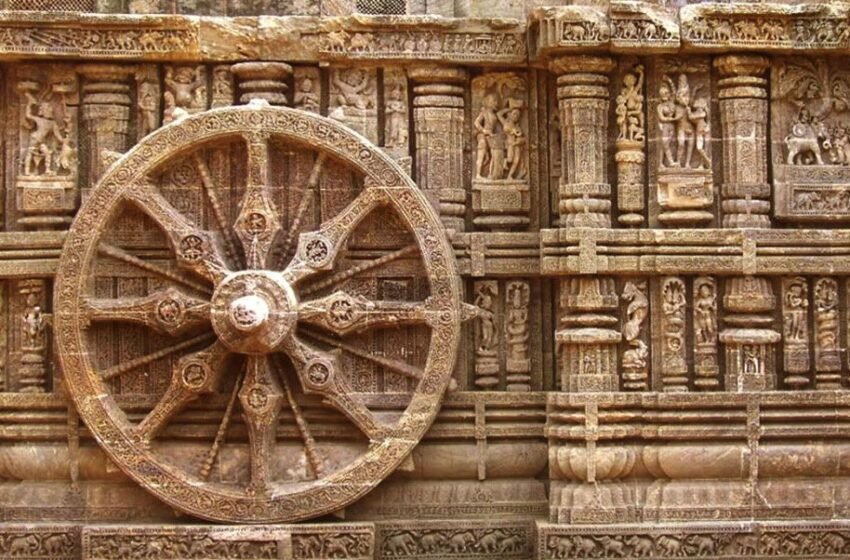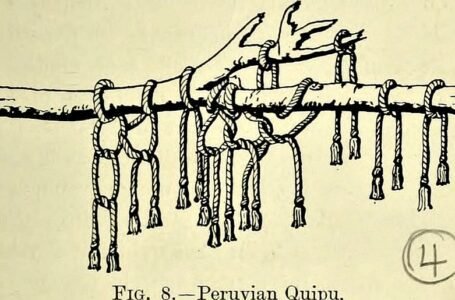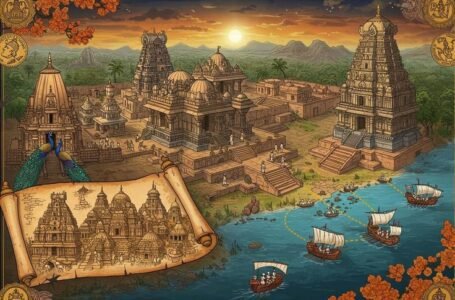Sundials, Shadows & Secrets: What Konark Teaches Us About Ancient Astronomy

-Vani Mishra
Odisha A beautiful gem on the east coast of India,Odisha is famous for its vibrant cultural heritage, classical dance forms and magnificent temples. Of these wonderous works of architecture, the Konark Sun Temple, looms large not only in a physical sense; but as an embodiment to the craft, brilliance, and cosmic knowledge of India’s ancient architects. When we think of ancient temples in India, we often imagine stone carvings, imposing structures, and great spiritual significance. But concealed in the artwork of Odisha’s Konark Sun Temple is another, lesser-known wonder, an astronomical tour de force that leaves scholars, scientists, and sightseers alike scratching their heads. “I must confess that I’ve been drawn to the mathematical as well as celestial secrets inscribed in stone at Konark by a person with a heritage and a scientific bent of mind.” Sun Temple at Konark is not only a dedication to Surya, the Sun God but an astronomic code encrypted in stone and this is how it goes. This piece delves into how the craftsmen and scholars of 13th century Odisha channelled cosmic principles into architectural grandeur and why despite all it’s loss, Konark is still a shining example of India’s ancient astronomical legacy.
Konark: The Temple City Synchronized with the Cosmos
Conceived in the 13th century CE by King Narasimhadeva I of the Eastern Ganga Dynasty, the Konark Sun Temple is a monumental representation of the chariot of the Sun God, with seven horses pulling the chariot across the sky. The temple is oriented to the east, so the east end is where one enters. It is built on a pyramidal platform along the west edge of a 600m by 800m Tablero arena. The western staircase is a continuation of the mountain that is carved, with 91 steps, one for each 4-day week, totalling 364.5 days. Harvest season for 2 cultivation cycles. Four more stairs on the jump that gives access to the calendric courtyard and the temples at the top. the lower stair is the access to Guedes temple. inner sanctum. This orientation is not coincidental; it is the first clue to the temple’s astronomical alignment. The concept of temple orientation in ancient India was closely linked with astronomy and cosmology. The eastward direction of Konark enabled it to function as a sun observatory. The positioning was designed such that sun rays would strike certain portions of the temple at various times throughout the day and year, functioning as a celestial clock and calendar.
The Wheels That Tell Time
One of the most recognizable aspects of the Konark temple is its 24 carved stone wheels, each measuring around 12 feet in diameter, arranged in a row on either side of the temple platform. They may look like decorations to the naked eye. However, the wheels have a much more profound purpose that is they are actually sun dials. There are eight large spokes and eight smaller ones on every wheel, which symbolize the day’s 24 hours. The shadows created by the spokes serve as indicators of time. When sunlight falls upon the wheel, the shadow of the spoke falls upon the hour marks inscribed into the stone, enabling onlookers to know the time with shocking precision even today to within a minute or two. It is estimated that these wheels also marked the time of various rituals and prayers that were to be done in the temple based on the sun’s position. Essentially, these were not just pieces of architecture; they were stone algorithms that cracked time.
Mathematical and Astronomical Accuracy
Aside from sundials, the temple demonstrates a deep appreciation of solar motion, trigonometry, and geometry. Ancient Indian astronomers or simply referred to as “nakshatra-vids” were experts in the computation of equinoxes, solstices, and celestial transit. Konark is reported to have translated this knowledge in its design and sculptures. For example, certain historians and archaeo-astronomers speculate that the location of certain sculptures around the temple can be related to zodiac constellations or celestial phenomena. The 12 pairs of wheels are assigned to the 12 months, and the structure of the temple is supposed to derive from a calendar system based on solar motion. In addition, the height and balance of the temple conform to ratios familiar from Vastu Shastra and ancient Indian mathematics by the name of the Sulba Sutras. These works include directions for the construction of altars with specified measurements and ratios that reflect their occurrence in celestial events. Konark seems to have extrapolated those principles onto a gigantic plinth.
The Mythology Behind the Mathematics
Although science behind Konark is astounding, it is firmly rooted with myth. The temple is in honor of Surya, the Vedic sun god. The temple, based on legend, was constructed to mark the healing of King Narasimhadeva’s son by Surya. This myth reinforces the connection of the sun not just with time, but also with healing, vision, and cosmic order. The imagery of the chariot and the wheels and horses that pull it is also connected to Vedic cosmology, as the sun is visualized as traveling across the sky in a heavenly chariot. This intersection of scientific accuracy and religious mythology is one of the things that makes Konark special. It was never about utilitarian purpose but about meaning, harmony, and seeking cosmic balance.
A Legacy of Ancient Astronomers
Surprisingly, Konark temple is not the sole temple that has used the assistance of astronomy in temple design. Throughout India, numerous temples are oriented in cardinal directions, solstice points, and even lunar periods. Konark stands apart from other architectural ancient temples by the absolute magnitude and coherence of its astronomical allusions. Odisha was a learning center, especially in astronomy and mathematics. Temples were not only sites of prayer but centres of knowledge. It is also known that the priests and temple architects at Konark were learned in astronomy and they employed astronomical aids such as gnomons and shadow tracing to design and implement the temple’s layout. Further, Odisha’s historical treatises such as the “Siddhanta Darpana” and “Surya Siddhanta” were formative works in Indian astronomy. These texts describe planetary motions, eclipses, and methods of keeping time that would have influenced temple architecture.
Preservation and Interpretation of the Konark Temple
Much of the temple still exists today. The central sanctum (vimana) collapsed centuries ago, perhaps because of a combination of structural stress and invasions. Even in ruins, the surviving remains of the temple like the jagamohana (audience hall), the wheels, and some sculptures still move scholars, archaeologists, and artists. Of late, there has also been a revival of the study of archaeo-astronomy in India and Konark easily finds itself at the center of such debates. Several 3D mapping and solar simulation studies have also been carried out to grasp the way the temple served as a solar calendar and clock. Preservation of what is left of the temple has been undertaken by the Archaeological Survey of India (ASI) and local groups, although issues such as erosion, tourism, and weathering continue.
Why is Konark still important?
Konark is not just an architectural marvel, it is a silent repository of celestial knowledge sculpted in stone. It defies the current architecture that ancient civilizations did not have scientific knowledge. The temple teaches us that science, art, and religion were once perfectly intertwined a phenomenon that contemporary education systems are slowly discovering again. During an era when science and the humanities tend to be in conflict, the Konark Sun Temple presents a powerful case study of just how deeply embedded these fields of study once were. It demonstrates how a culture’s concept of time, space, and the universe can be invested in something as permanent and beautiful as stone wheels.
Conclusion
The Odisha Temple Astronomers did not merely construct a monument. They made a living, tool of heavenly computation. The Konark Sun Temple stands as a testament to ancient India’s scientific past, wrapped in legend, myth, and geometry, and lit up by the sun. By unravelling its stellar algorithms, we not only know more about the past but also re-imagine how the future of architecture, astronomy, and cultural heritage may come to align once more as they once did under the eastern rays of the rising sun.


